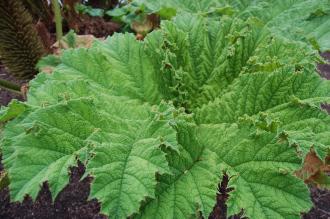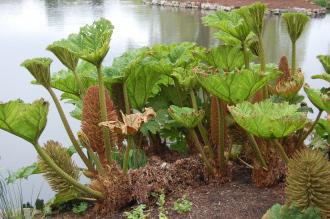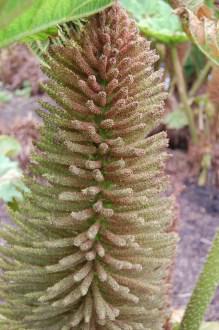
Gunnera manicata Leaf 05/05/2012, Kew Gardens, London)
Position: Full sun to shade
Flowering period: Early summer
Soil: Moist, poorly drained
Eventual Height: 2.5m
Eventual Spread: 4m
Hardiness: 7a – 10a
Family: Gunneraceae
Gunnera manicata is a large herbaceous perennial which forms a spreading clump. Its dark green leaves are palmate, roughly textured and have prickly undersides, deeply ribbed, up to 2m across and are coarsely toothed margins. Its leaves are borne on thick, succulent leaf stalks which grow up to 2.5m long, these have spines which may cause an allergic reaction. Its small reddish flowers are arranged on a large spadix which may be up to 1m tall. Its fruit is dark green, becoming red in autumn.

Gunnera manicata (05/05/2012, Kew Gardens, London)
Gunnera manicata, commonly known as Giant Gunnera, Chile Rhubarb or Giant Rhubarb, is native to south east Brazil. It was first introduced into Europe in the 1860′s by J.J Linden. Gunnera manicata is synonymous with Gunnera brasiliensis.
The etymological root of the binomial name Gunnera is named after Johan Ernst Gunner (1718-1773), a Norwegian botanist and founder of the Royal Norwegian Society. Manicata is from the Latin meaning ‘having long sleeves’, possibly in reference to the hairy ‘trunks’.
The landscape architect may find Gunnera manicata useful as a specimen plant, where space allows,at the edge of ponds or lakes.

Gunnera manicata Flower Spadix (05/05/2012, Kew Gardens, London)
Ecologically, G. manicata is attractive to bees and pollinating insects.
The Royal Horticultural Society has given G. manicata their prestigious Award of Garden Merit in 1993.
G. manicata prefers moist, humus rich, fertile, poorly drained soils. It tolerates most pH of soil. It will not tolerate dry soils.
Gunnera manicata requires little maintenance. In the winter in the UK the dead leaves should be left on the plant to protect the crown.

